- Day 1: North Point, Central, and Victoria Peak
- Day 2: Cheung Chau
- Day 3: Kowloon Walled City Park and the Ritz-Carlton
Day 1: North Point, Central, and Victoria Peak
Since the earliest days of Hong Kong, trade has been the foundation of its economy. The city’s key advantage? Victoria Harbour, a strategically located natural deepwater shelter which ranks among the world’s busiest ports. Accordingly, the Hyatt Centric Victoria Harbour is where we began our first full day in Hong Kong after a late-night arrival.

This hotel is located in the aptly named North Point, the geographically northernmost part of Hong Kong Island. Although North Point is a mostly residential area, it is by no means an inconvenient place to stay because, like all urban areas of Hong Kong, it has a plethora of transit options including a metro station, tram line, various bus routes, and even a ferry terminal.
Among these options, the coolest one is obviously the double-deck tram, arguably Hong Kong’s most iconic vehicle, so we did not hesitate to ride it. Trams have been running in Hong Kong since July 1904, making the system the second oldest among those still operating in East Asia, behind only the Tosaden Kōtsū in Kōchi, Japan. While the current trams were built in the 2000s, they still lack air conditioning, which is the biggest drawback compared to the metro or buses.

In North Point, the tram line has a very noteworthy layout: the track passes through a street market. Not all trams go into this section, but it is worth going there just to experience the ride.

Fortunately, because the market is not on the main road and mostly sells goods intended for locals, few tourists have a chance to discover this unique place and it is not overrun by visitors.

After leaving the market, trams merge back onto the main line, which traverses the northern side of Hong Kong Island, the core part of Hong Kong containing many famous landmarks. Even though the metro covers almost the same route and is faster, it runs entirely underground in the city center and thus is far less interesting to ride.

Going by tram all the way from North Point to Central took quite some time, but we enjoyed the views from the front of the upper deck. Hong Kong is a city with an incredibly distinct character; take any random, unremarkable street, and it could still never be mistaken for a place anywhere else in the world. To be fair, not all aspects of this are positive, such as the aging concrete buildings or the lack of greenery and open space. However, from the perspective of a visitor, soaking up the ambience in Hong Kong is something memorable in itself.

We alighted in front of the Central Market, a former wet market renovated to become a more modern retail space.

Many of the businesses were closed because it was too early, while others were vacant, but we were able to find a coffee stand that was open.

After having coffee, we proceeded to the Central–Mid-Levels escalator, which is directly connected to the Central Market. This chain of escalators covers a total distance of more than 800 m uphill, a distinctive solution adapted to Hong Kong’s hilly topography.

Some sections of the escalator pass through very steep and narrow spaces, creating far more direct routes than the conventional roads.

Because the escalator puts this area within walking distance of the central business district, the housing here is some of the most expensive in Hong Kong. Considering that Hong Kong as a whole is already the world’s priciest housing market in terms of cost per square meter, the property values in these buildings must be astronomical. But even if money is no object, the quality of life here may be highly questionable — many of the buildings are dilapidated and the units cramped and miniscule.

Upon reaching the top, we had to go back down by foot since the escalator is single-sided and always runs uphill except during the morning rush hour. Along the way, we came upon a memorial to José Rizal, who is universally viewed as a national hero in the Philippines for his opposition to Spanish colonialism. He lived and worked in this part of Hong Kong for several months in 1890-91 after leaving Europe and before returning to his homeland. Ironically, while the Philippines declared independence in 1898, Hong Kong itself would remain under British control for almost another century, until 1997.
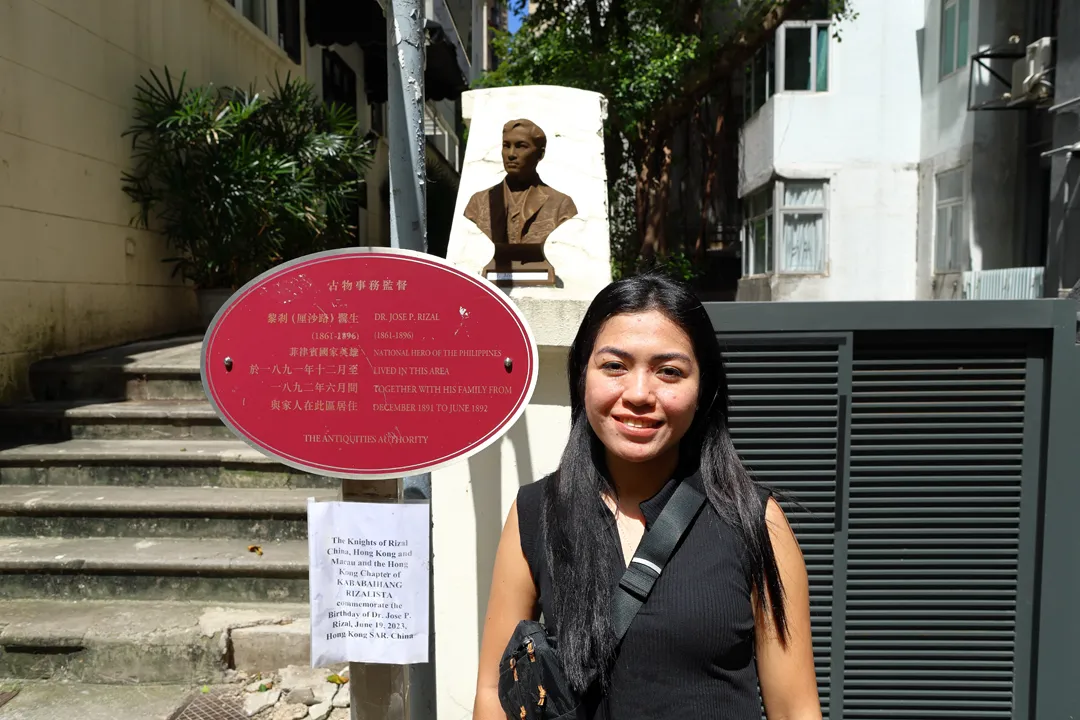
Back in Central, we looked for a place to eat but it was extremely hard to decide, and we wandered around for more than an hour.
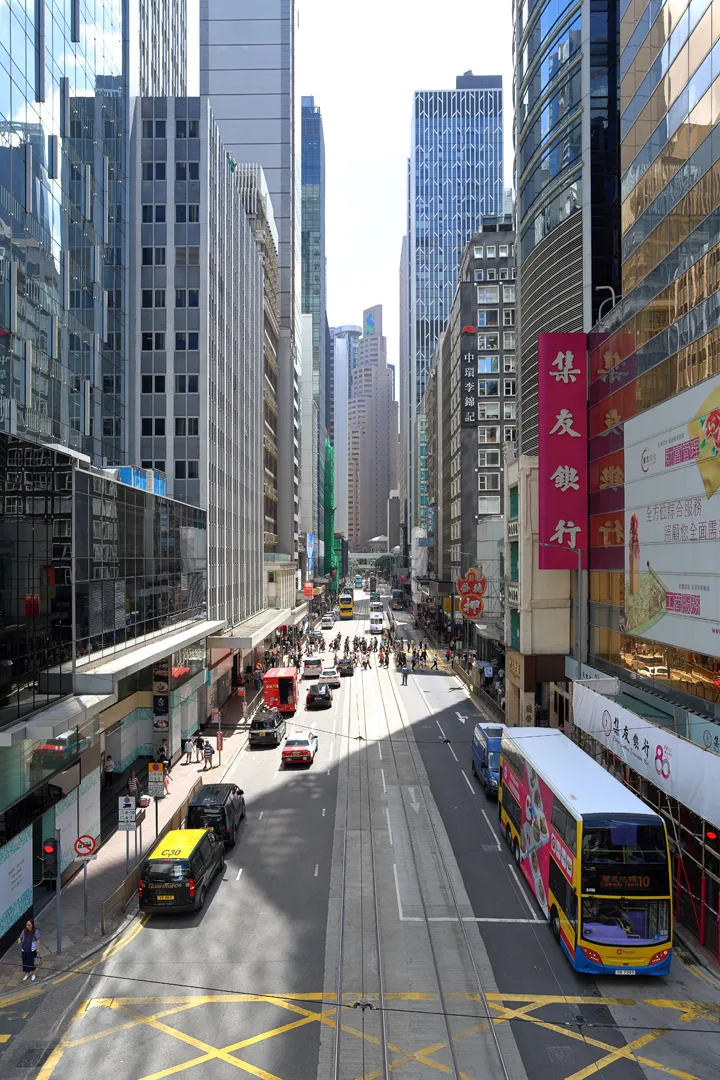
An extensive network of pedestrian overpasses connects numerous buildings in Central, so it is possible to reach many places without having to cross streets at ground level. It is reminiscent of Montreal, but elevated instead of underground.

We also found a park, unfortunately an exceedingly rare sight in Hong Kong’s city center, although it was relatively uncrowded considering how many people were in the vicinity. Could it be that the locals simply prefer air-conditioned spaces?

Eventually, we picked a restaurant serving char siu pork, a classic Cantonese dish. It was a great choice and very satisfying.

By the time we finished eating, it was already mid-afternoon. We had to head for our last destination of the day, Victoria Peak. The bus ride from Central takes one hour or so, and instead of boarding at the nearest stop, we walked further to the first stop on the route, which made it easy to get the seats with the best view in the front.
At the peak, we had to find the best unobstructed viewpoint. This involved some more walking, along the misleadingly named Lugard Road (actually just a pedestrian path). Then, we had to wait there until sunset, but this was all a worthwhile effort, since it would be preposterous to visit Hong Kong without seeing this renowned view of the city.

Before returning to the bus terminal, we stopped at another viewpoint, the Lion Pavilion. It is not quite as good because there are likely to be more people and the view is partially obstructed by trees, but it is easier to find and has better facilities. The traditionally styled architecture also presents an interesting contrast with the skyscrapers below. We took some more photos here until it started to get too dark. More importantly, we had not eaten dinner yet, so it was time to head back.

Day 2: Cheung Chau
In addition to Hong Kong Island itself, the Hong Kong SAR contains more than 250 other islands. Unlike the very dense and crowded urban core, these outlying islands are sparsely populated, being home to less than 200,000 of the territory’s 7.5 million residents. However, the well-developed ferry network makes it surprisingly easy to travel to the towns there.
Most ferries to the islands depart from the main piers in Central. From North Point, it is actually possible to reach Central entirely via ferry by way of Hung Hom on the Kowloon side. The Hyatt Centric is conveniently located right next to the pier, so of course we attempted this. Fortunately, the connection window at Hung Hom was perfect, neither too long nor too short, and we made it to Central easily.

At Central, the ferries to our destination, Cheung Chau, use Pier 5. There are as many as 43 departures per day, including one at 04:15 in the morning, when even the metro would not be running. There are two categories of ferry, the ordinary ferry and the fast ferry, which costs almost double but has air conditioning. We chose the fast ferry as it was the next available one.

We arrived uneventfully in Cheung Chau in just over half an hour.

It may be hard to believe that a fishing port like this could be just 15 km away from the gleaming skyscrapers of Central, or indeed even part of Hong Kong at all. To come here is to experience an unfamiliar side of Hong Kong, one rarely shown on TV or in cinemas.

In order to decide which way to go, we examined the tourist map outside the ferry terminal. Cheung Chau is shaped roughly like an inverted letter Y, and we settled on heading toward the southwest corner. This route first took us along the waterfront of the town.

The population of Cheung Chau is approximately 23,000. Unlike in Japanese towns of similar size, such as Takahashi, we saw enough people out and about for the atmosphere to feel at least somewhat lively. A possible factor is that cars are not allowed on the island (there are no roads wide enough to accomodate them), meaning that people must rely on walking or cycling. Taking into account that the distance from one end of the town to the other is hardly more than 1 km, the disadvantages of cars would far outweigh the advantages anyway.

We followed the path out of the town and then through a wooded area until we reached a small cove on the island’s southern coast.

From there, we proceeded toward the west along the shoreline, but shortly we came to another small cove where there was a dead end in the path. With the ocean on one side and fenced-off private property on the other, there was no other choice but to turn back.

By this point, we had covered a mere 2 km on foot, and on paved surfaces, no less, but the overwhelming heat and humidity made the idea of further exploration extremely unappealing. We rested for a while on a shaded bench, and after that, the only sensible option was to return to the town.

We poked around in the town for a bit, but we no longer had the energy to do much. At least the narrow streets create plenty of shade.

The town is compact and easy to navigate, its layout being centered on the narrowest section of the island, where the western shore is no more than 200 m from the eastern shore. But while the former has been turned into one big anchorage for the armada of fishing boats, the latter has fortunately been spared the concrete treatment and remains a natural beach.

Here, we concluded our visit to Cheung Chau earlier than originally planned. Since we were not inclined to go out in the sun any more, we decided to go back to the city aboard the next ferry.

However, this change of plans gave us a lot more spare time in the evening. Back at the hotel, we showered first, and then set off for Central again, this time using the metro. In Hong Kong after dark, opportunities abound for photography — it is very safe, much less crowded than during business hours, and there is no shortage of interesting scenes.

Using the pedestrian overpasses, we walked to a corner near the Bank of China Tower, one of Hong Kong’s most well-known landmarks. This seemed to be a popular spot as there was a class of photography students there learning how to take long exposure photos.

I finished capturing some shots that I was satisfied with, and we started our journey back once more, now on a tram instead. As mentioned before, Hong Kong’s trams are not air conditioned, which is an inconvenience during the day. It is a different story at night, when the outside temperature is more pleasant and the ability to open the windows is hugely beneficial since doing so completely eliminates reflections in photos. There is also the possibility for various perspectives which are impossible to get from inside a fully enclosed vehicle such as a bus.

Even if without a camera in hand, the sensations of a nighttime tram ride are incomparable. The glitter of the ubiquitous neon lights, unobstructed by dirty glass. The ambient sounds and smells of the city, delivered by a rush of cool wind each time the tram accelerates. No doubt, it is a quintessential way to experience Hong Kong.

The cost of this unforgettable experience? A trivial fare of HK$3, the lowest of any mode of public transport in Hong Kong, and an uncommon bargain in a city well known for its exorbitant cost of living.

The ride passed quickly; it was certainly more enjoyable than making the same trip during rush hour. Soon, we were again approaching North Point.

At the tram loop, the market was still busy, now with more younger people shopping after work. We found a Thai restaurant nearby and ate a quick dinner. It had been a tiring day and we could not wait to rest.

Day 3: Kowloon Walled City Park and the Ritz-Carlton
Unsurprisingly, the first place in Hong Kong to be developed was Hong Kong Island. However, the very limited amount of flat land there made it inevitable that the city would eventually expand to the other side of Victoria Harbour, an area which became known as Kowloon (九龙, literally meaning “nine dragons”). Today, Kowloon is also considered part of Hong Kong’s urban core, and its population greatly exceeds that of Hong Kong Island.
Getting to Kowloon is very simple: there are a multitude of metro, bus, and ferry routes available. We chose to ride a bus, which takes only a few minutes to go through a tunnel underneath Victoria Harbour.

Compared to the Hong Kong side, the Kowloon side features wider streets, somewhat more greenery, and generally newer buildings, all of which signify its more recent development. These factors contribute to an atmosphere that feels less crowded, even though statistically, Kowloon is the most densely populated region of the Hong Kong SAR.

However, there were also more private cars and significant traffic congestion. Even in a city where more than 90% of trips are made using public transport, the highest share in the world, this problem can still manifest.
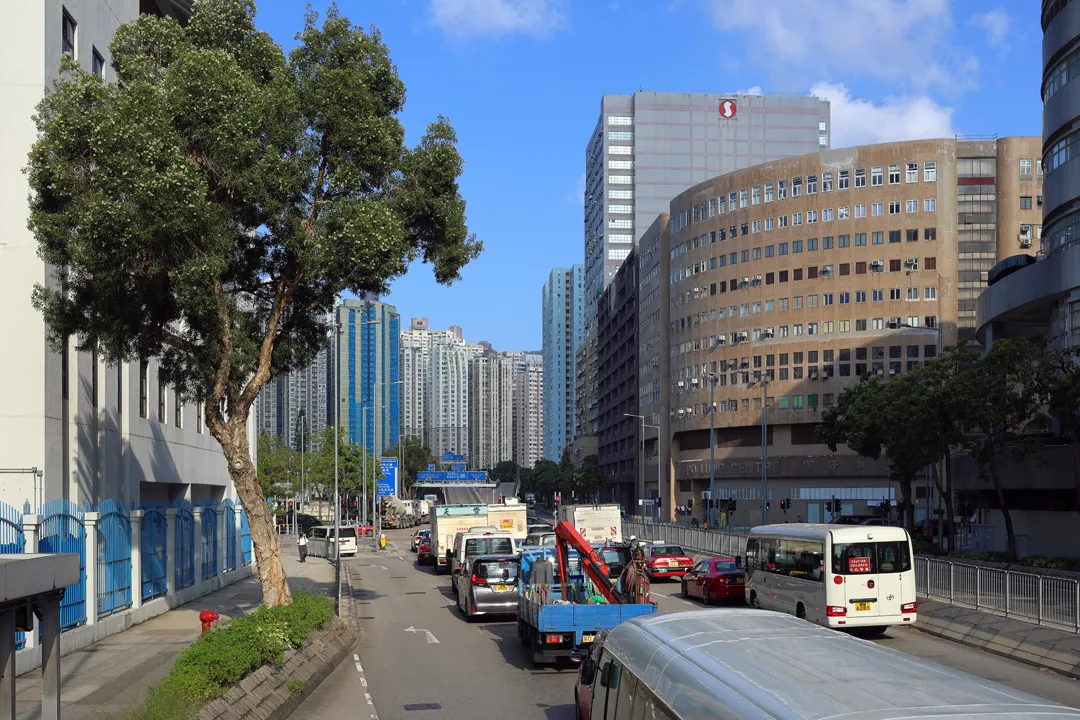
All of the traffic was concentrated at the expressway entrance.

When entering the curve, it became clear that the expressway ramp had been completely blocked by a crash in the other direction, so hopefully, the level of congestion that we witnessed was an abnormality and not a recurring part of daily life in this area.

Once we passed the location of the crash, the road became mostly empty. We were going northwest and could see Lion Rock in front, above the skyline. It was also apparent that there was at least 1 km of vehicles heading the opposite way, unable to move at all…

Eventually, we made it to the Kowloon Walled City Park, named after the settlement that existed on the site from the late 1940s until 1993. The Kowloon Walled City was infamous for being a lawless place that was effectively beyond the reach of government authority, and additionally for its extreme population density — it was home to at least 35,000 people despite being less than 0.03 km² in size (not even half as large as the terminal of Hong Kong International Airport). Between 1993 and 1995, it was evacuated, demolished, and replaced with this park.

The park is designed to resemble a traditional Chinese garden, few examples of which exist in Hong Kong. Although it is attractive, well maintained and has historical significance, it is far from metro stations and the bus system is potentially confusing for visitors, so we saw few tourists here.

On the other hand, it is hard to overstate the contributions of parks to improving the quality of life for local residents, especially in an overcrowded metropolis like Hong Kong. When the government demolished the Kowloon Walled City, using the land for a park instead of more buildings was a wise decision that continues to provide benefits nearly 30 years later.

With it being the middle of a working day, not many locals were around either. We explored the park at a leisurely pace.
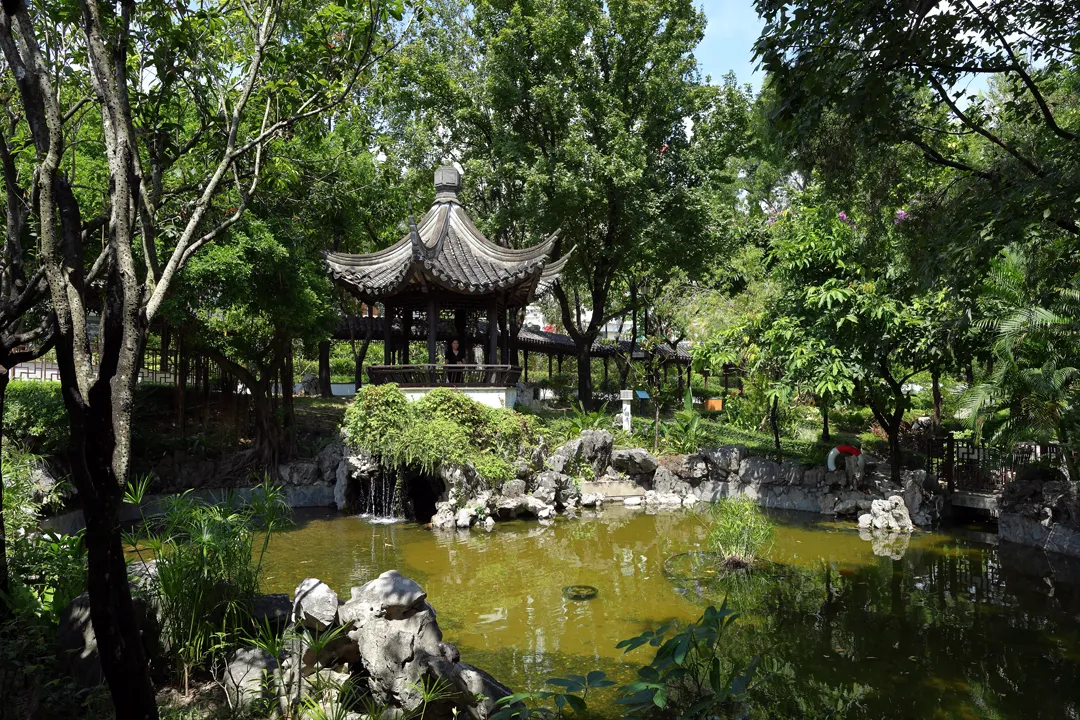
It is almost unthinkable that a concrete jungle more than 10 stories tall once stood here, its improvised buildings packed together so tightly that no sunlight could reach the ground. No trace of its existence remains except for a few small Qing dynasty military buildings in the center, which predate the settlement by several decades.

Among the modern parts of the park, a quirky one is an area containing statues of all twelve zodiac animals, even the mouse. The two of us had the good fortune of being born in the same calendar year; thus, we share the same zodiac animal.

At this point, we had nearly completed a full loop around the park and were soon back to the main entrance on the southern side.

For our last night in Hong Kong, we stayed at the Ritz-Carlton, which also happens to be found in Kowloon. The selection of five-star hotels in Hong Kong is very extensive and includes world-famous establishments like The Peninsula and the Mandarin Oriental, but the Ritz-Carlton has the undeniable advantage of being located in the uppermost floors of the city’s highest building. A room with a view of Victoria Harbour cost us HK$6300, more or less the same as the competition (who lack comparable views).

Our room was nominally on floor 110, but the building in fact has only 108 physical floors; the architects skipped numerous floors in the numbering scheme due to old superstitions. Nonetheless, we were at an approximate height of 450 m, equivalent to the upper observation deck of the Tokyo Skytree and slightly higher than the public viewpoints on Victoria Peak. This perspective makes it obvious how little flat land is available on Hong Kong Island.

We stayed inside for the rest of the day because it would have been a shame to go anywhere else after booking such an expensive hotel room. Luckily, the weather was clear with excellent visibility, although the sunset was not colorful.

The view was so captivating that even when we went to bed, we left the curtains open.

Early the next morning, rain was sweeping across Hong Kong, but this was also interesting to observe from up high.

Our flight was in the afternoon, so we had a lazy morning watching the clouds gradually clear.

However, there was one more thing that we needed to do before checking out, which was to visit the pool. Found at the top floor of the building, 476m above sea level, it was the highest swimming pool in the world at the time of the hotel’s opening in 2010.

Relaxing in the hot tub area for a while was nice because of the better viewing angles toward the east.
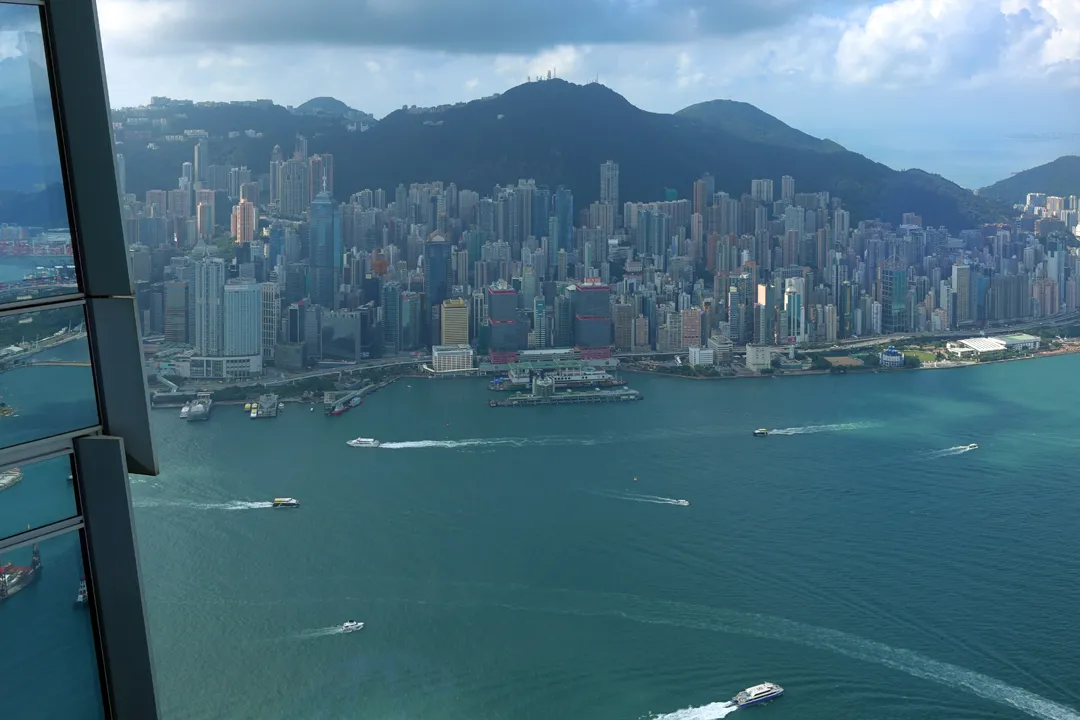
The major port facilities for large cargo ships can be seen from there, as well as the expressways leading to the airport and mainland China.

Finally, we checked out as close to noon as possible and ate lunch in one of the hotel’s restaurants, where the buffet even had lobster. As our last meal in Hong Kong, it was particularly memorable.

Since the hotel’s building is directly connected to the Kowloon station of the metro, it was easy to ride the Airport Express to the terminal. With this short stay in Hong Kong complete, our next destination awaited.
